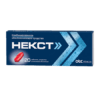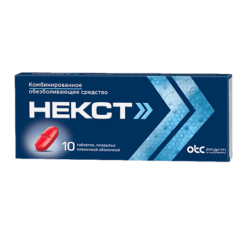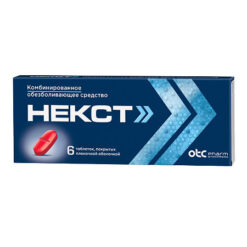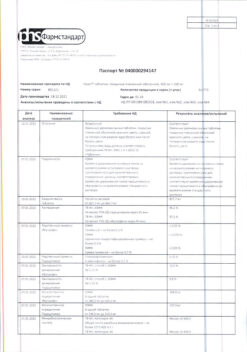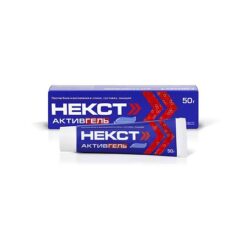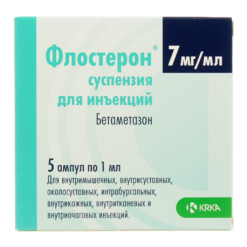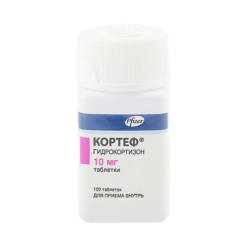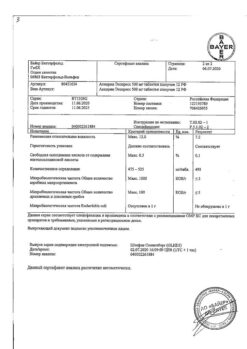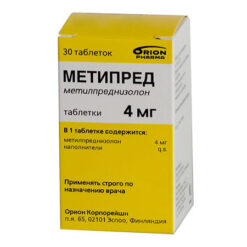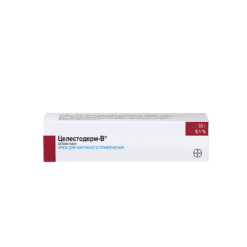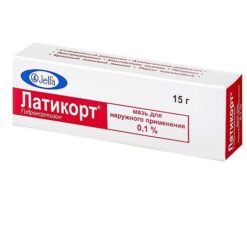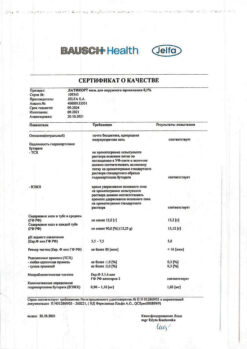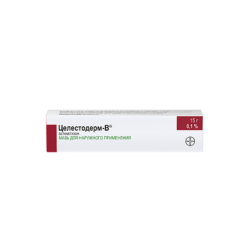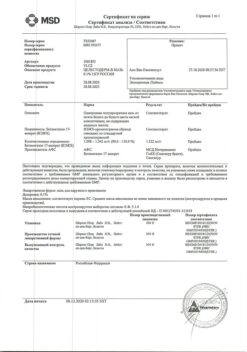No products in the cart.
Next, 400 mg+200 mg 20 pcs.
€8.76 €7.66
Description
Pharmacotherapeutic group:
an analgesic combined
(NSAID + non-narcotic analgesic)
ATX code: M01AE51
Pharmacological properties
Indications
Indications
– Headache (including migraine);
– toothache;
– algodismenorrhea (painful menstruation);
– neuralgia;
– myalgia;
– back pain;
– joint pain, pain syndrome in inflammatory and degenerative diseases of the musculoskeletal system;
– pain from bruises, sprains, dislocations, fractures;
– post-traumatic and postoperative pain syndrome;
– febrile conditions (including flu and colds).
The drug is used as a means of symptomatic treatment of feverish conditions, headaches, muscle pain in acute respiratory diseases and influenza. The drug is intended for symptomatic therapy, reducing pain and inflammation at the time of use, does not affect the progression of the disease.
Pharmacological effect
Pharmacological effect
Pharmacotherapeutic group:
combined analgesic
(NSAID + non-narcotic analgesic)
ATX code: M01AE51
Pharmacological properties
Special instructions
Special instructions
The simultaneous use of the drug with other drugs containing paracetamol and/or non-steroidal anti-inflammatory drugs should be avoided.
When used simultaneously with indirect anticoagulants, monitoring of hemostasis is necessary.
When using the drug for more than 5-7 days, peripheral blood counts and the functional state of the liver should be monitored.
Paracetamol distorts the results of laboratory tests of glucose and uric acid in blood plasma.
If symptoms of NSAID gastropathy appear (nausea, vomiting, abdominal pain, heartburn, loss of appetite, flatulence, discomfort in the epigastric region), careful monitoring is indicated, including esophagogastroduodenoscopy, a blood test to determine hemoglobin and hematocrit, and a stool test for occult blood.
If it is necessary to determine 17-ketosteroids, the drug should be discontinued 48 hours before the study.
During the treatment period, drinking alcohol-containing drinks is not recommended.
Impact on the ability to drive vehicles and machinery
While taking the drug, patients should refrain from all activities that require increased attention, rapid mental and motor reactions.
Active ingredient
Active ingredient
Ibuprofen, Paracetamol
Composition
Composition
Active ingredients: ibuprofen – 400 mg, paracetamol – 200 mg.
Excipients:
core: calcium hydrogen phosphate – 80.0 mg, microcrystalline cellulose – 64.5 mg, croscarmellose sodium – 24.3 mg, hyprolose (hydroxypropylcellulose) – 19.3 mg, talc – 12.1 mg, magnesium stearate – 7.3 mg, colloidal silicon dioxide (aerosil) – 2.5 mg;
shell:
OPADRAY 20А250004 RED (OPADRY 20А250004 RED) [hypromellose (hydroxypropyl methylcellulose) – 13.1 mg, hyprolose (hydroxypropylcellulose) – 8.1 mg, talc – 6.4 mg, titanium dioxide – 2.5 mg, crimson dye [Ponceau 4R] (E 124) – 0.9 mg, sunset yellow dye (E 110) – 0.5 mg] – 31.5 mg, OPADRY II 85F19250 TRANSPARENT (OPADRY II 85F19250 CLEAR) [macrogol (polyethylene glycol) – 0.3 mg, polyvinyl alcohol – 1.0 mg, polysorbate 80 – 0.1 mg, talc – 0.6 mg] – 2.0 mg.
Pregnancy
Pregnancy
If it is necessary to use the drug in the first and second trimester of pregnancy, caution should be exercised – use is only possible as prescribed by a doctor in cases where the potential benefit outweighs the possible risk. The use of the drug in the third trimester of pregnancy is contraindicated.
During breastfeeding, if necessary, use the drug
breastfeeding should be stopped.
Contraindications
Contraindications
– Hypersensitivity to the components of the drug, including other non-steroidal anti-inflammatory drugs (NSAIDs);
– erosive and ulcerative diseases of the gastrointestinal tract (in the acute phase), gastrointestinal bleeding;
– progressive kidney disease;
– severe renal failure (creatine clearance (CC) less than 30 ml/min.);
– severe liver failure or active liver disease;
– blood clotting disorders (hemophilia, prolongation of bleeding time, bleeding tendency, hemorrhagic diathesis);
– cerebrovascular or other bleeding;
– complete or incomplete combination of bronchial asthma, recurrent polyposis of the nose and paranasal sinuses and intolerance to acetylsalicylic acid or other non-steroidal anti-inflammatory drugs, incl. in the anamnesis;
– chronic heart failure (functional class III-IV according to the NYHA classification);
– condition after coronary artery bypass surgery;
– confirmed hyperkalemia;
– deficiency of glucose-6-phosphate dehydrogenase;
– pregnancy (III trimester);
– breastfeeding period;
– children under 18 years of age.
With caution
Chronic heart failure; viral hepatitis, alcoholic liver damage, liver and/or kidney failure of moderate and mild severity, benign hyperbilirubinemia (Gilbert, Dubin-Johnson and Rotor syndrome), liver cirrhosis with portal hypertension, nephrotic syndrome; diabetes mellitus, peripheral arterial disease, peptic ulcer of the stomach and duodenum (history); gastritis, enteritis, colitis; bronchial asthma, bronchospasm; old age; pregnancy (I and II trimesters – use is possible only as prescribed by a doctor in cases where the potential benefit outweighs the possible risk).
Side Effects
Side Effects
Side effects are listed with the frequency of occurrence in accordance with the WHO classification: very common (with a frequency of more than 1/10), often (with a frequency of at least 1/100, but less than 1/10), uncommon (with a frequency of at least 1/1000, but less than 1/100), rarely (with a frequency of at least 1/10,000, but less than 1/1000), very rare (with a frequency of less than 1/10000, including isolated messages), frequency unknown (cannot be determined from available data).
From the nervous system: infrequently – headache, dizziness, sleep disturbances, anxiety, hallucinations, confusion, rarely – aseptic meningitis, very rarely – depression.
From the cardiovascular system: often – peripheral edema, very rarely – tachycardia, increased blood pressure, heart failure.
From the respiratory system: very rarely – shortness of breath, bronchospasm.
From the gastrointestinal tract: often – abdominal pain, nausea, vomiting, heartburn, loss of appetite, diarrhea, flatulence, erosive and ulcerative lesions of the gastrointestinal tract; uncommon – constipation, ulceration of the gum mucosa, aphthous stomatitis, pancreatitis, gastrointestinal bleeding.
Sense organs: very rarely – hearing impairment, ringing or tinnitus, visual impairment, blurred vision or diplopia, frequency unknown – dry and irritated eyes.
From the urinary system: very rarely – acute renal failure, nephrotic syndrome, cystitis; frequency unknown – polyuria.
Allergic reactions: uncommon – skin rash, itching, allergic rhinitis, angioedema; very rarely – exudative erythema multiforme (including Stevens-Johnson syndrome), toxic epidermal necrolysis (Lyell’s syndrome).
From the hematopoietic organs: very rarely – anemia, thrombocytopenia, thrombocytopenic purpura, agranulocytosis, leukopenia, eosinophilia.
From the skin and subcutaneous tissues: often – hyperhidrosis.
With long-term use in large doses – hepatotoxic and nephrotoxic effects (hepatitis, interstitial nephritis and papillary necrosis); hemolytic anemia, aplastic anemia, methemoglobinemia, pancytopenia.
If side effects occur, you should consult a doctor.
Interaction
Interaction
Inducers of microsomal oxidation in the liver (phenytoin, ethanol, barbiturates, flumecinol, rifampicin, phenylbutazone, tricyclic antidepressants) increase the production of hydroxylated active metabolites, which makes it possible to develop severe intoxication in case of overdose.
Inhibitors of microsomal oxidation (including cimetidine) reduce the risk of hepatotoxicity.
Myelotoxic drugs increase the manifestations of hematotoxicity of the drug.
Cyclosporine and gold preparations increase the nephrotoxicity of the drug.
The combination of ibuprofen with ethanol and glucocorticosteroids increases the risk of erosive and ulcerative lesions of the gastrointestinal tract.
Concomitant use of paracetamol with ethanol increases the risk of acute pancreatitis.
Paracetamol and ibuprofen enhance the effect of indirect anticoagulants and reduce the effectiveness of uricosuric drugs.
Long-term use of barbiturates reduces the effectiveness of paracetamol.
Diflunisal increases the plasma concentration of paracetamol by 50%, which increases the risk of hepatotoxicity.
Ibuprofen reduces the hypotensive activity of vasodilators, natriuretic and diuretic – furosemide and hydrochlorothiazide.
Antacids and cholestyramine reduce the absorption of ibuprofen.
Caffeine increases the analgesic effect of ibuprofen.
Ibuprofen enhances the effect of oral hypoglycemic agents and insulin.
Ibuprofen increases the blood concentration of digoxin, lithium and methotrexate.
When administered simultaneously with acetylsalicylic acid, ibuprofen reduces its anti-inflammatory and antiplatelet effect.
Cefamandole, cefaperazone, cefotetan, valproic acid, plicamycin increase the incidence of hypoprothrombinemia.
Overdose
Overdose
Symptoms: abdominal pain, nausea, vomiting, agitation or lethargy, drowsiness, confusion, tachycardia, arrhythmia, acute renal failure, metabolic acidosis, frequent urination, pyrexia, headache, tremor or muscle twitching; increased activity of “liver” transaminases, increased prothrombin time. If you suspect an overdose, you should immediately seek medical help.
Treatment: gastric lavage, followed by the administration of activated charcoal; alkaline drinking, forced diuresis, symptomatic therapy, administration of sulfhydryl group donors (acetylcysteine) and precursors for glutathione synthesis (methionine).
Storage conditions
Storage conditions
In a place protected from light, at a temperature not exceeding 25 °C.
Shelf life
Shelf life
2 years
Manufacturer
Manufacturer
Pharmstandard-Leksredstva, Russia
Additional information
| Shelf life | 2 years |
|---|---|
| Conditions of storage | In a light-protected place at a temperature not exceeding 25 °C. |
| Manufacturer | Pharmstandard-Leksredstva, Russia |
| Medication form | pills |
| Brand | Pharmstandard-Leksredstva |
Other forms…
Related products
Buy Next, 400 mg+200 mg 20 pcs. with delivery to USA, UK, Europe and over 120 other countries.





